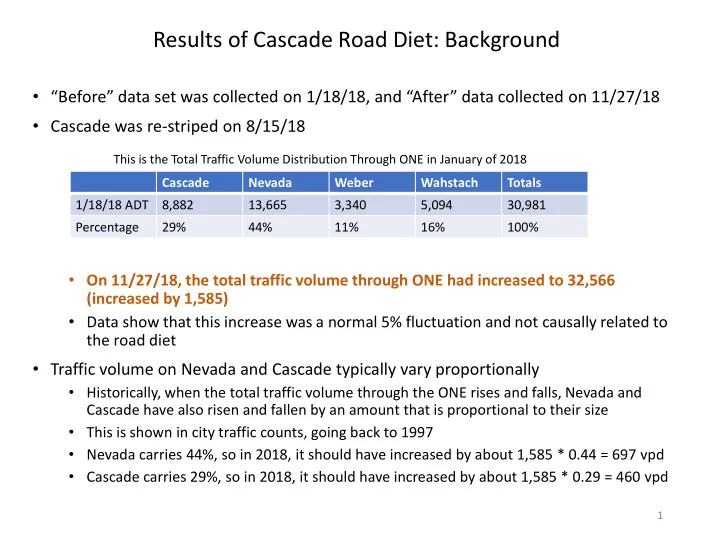

Results of Cascade Road Diet: Background • “Before” data set was collected on 1/18/18, and “After” data collected on 11/27/18 • Cascade was re-striped on 8/15/18 This is the Total Traffic Volume Distribution Through ONE in January of 2018 Cascade Nevada Weber Wahstach Totals 1/18/18 ADT 8,882 13,665 3,340 5,094 30,981 Percentage 29% 44% 11% 16% 100% • On 11/27/18, the total traffic volume through ONE had increased to 32,566 (increased by 1,585) • Data show that this increase was a normal 5% fluctuation and not causally related to the road diet • Traffic volume on Nevada and Cascade typically vary proportionally • Historically, when the total traffic volume through the ONE rises and falls, Nevada and Cascade have also risen and fallen by an amount that is proportional to their size • This is shown in city traffic counts, going back to 1997 • Nevada carries 44%, so in 2018, it should have increased by about 1,585 * 0.44 = 697 vpd • Cascade carries 29%, so in 2018, it should have increased by about 1,585 * 0.29 = 460 vpd 1
Results of Cascade Road Diet: Cascade Speed Changes on Cascade after Road Diet 4500 Speed Limit Cascade Traffic Volume (Vehicles per Day) 4000 Cascade S Before 3500 Location Before Road Diet After Road Diet Change 3000 Number of Cars South of Fontanero 8,882 8,814 -68 Cascade S After 2500 2000 On Cascade (south of Fontanero), there were 68 fewer vehicles after the road diet, despite substantial growth 1500 elsewhere through the Old north End 1000 500 0 • Traffic Volume 0 10 20 30 40 50 60 70 -500 Speed (mph) • Change in the total number of vehicles is marginal • Small increase north of Fontanero, and small decrease south • This occurred during substantial increase in traffic volume across the ONE • 1,585 * 0.29 = 460 vehicles should have been added : 460 + 68 = 528 were diverted • Speed Distribution This is fantastic! • Shifted approx. 5 mph to lower speed • Before Road Diet, there were 970 vehicles above 45 mph, and 62 over 55 mph • After Road Diet, there were 92 over 45 mph and 0 over 55 • Still, nearly everyone is above the speed limit – they are not badly inconvenienced 2
Results of Cascade Road Diet: Nevada Speed Changes on Nevada after Road Diet 7000 6000 Nevada Traffic Volume (Vehicles per Day) 5000 Number of Cars Nevada N before Location Before Road Diet After Road Diet Change 4000 Nevada N After South of Fontanero 13,665 14,756 +1,091 3000 2000 • Traffic Volume 1000 0 • Substantial growth in the number of vehicles 0 10 20 30 40 50 60 70 -1000 • 8.0% more south of Fontanero Speed (mph) • This is well beyond the measurement uncertainty • We conclude that there has been significant diversion to Nevada • While Nevada typically carries 44% of the N/S burden, it took on 72% of the growth • Expect growth to be 1,585 * 0.44 = 697 vehicles, 1,091 – 697 = 394 extra vehicles beyond expected growth • Speed Distribution • Very few cars are actually going slower • The lower mean speed can be accounted for by increase in traffic volume • Speed limit reduction (from 35 to 30 mph) had no measurable effect • Distribution is a bit broader, which means cars interact more (some slow, some fast) • This is a more dangerous situation 3
Results of Cascade Road Diet: Other North/South Streets Traffic Volume (Vehicles per Day) Location Before Road Diet After Road Diet Change Wood 547 554 +7 Tejon 598 552 -46 Weber 3,340 3,476 +136 Wahsatch 5,093 5,520 +427 • Traffic Volume • Changes on Wood & Tejon (adjacent to Cascade) are statistically insignificant • This conclusively demonstrates that Cascade road diet does not divert cars to two-lane roads • Wahsatch (like Nevada) took on more than its proportional share (427 vs 253) 4
Recommend
More recommend